Published: April 2002
|
|
Hard nosegear landings can produce heavy loads on the nosegear and its support structure. The resulting high stresses in the forward fuselage upper crown and between the flight deck and wing front spar can cause the fuselage structure to buckle. Appropriate actions by the flight crew can help prevent such incidents. Understanding which actions are appropriate requires a discussion of the following:
- Incidents of hard nosegear landings.
- Structural design requirements.
- Airplane control during landing and de-rotation.
1. INCIDENTS OF HARD NOSEGEAR LANDINGS
Recent incidents of hard nosegear touchdown share two characteristics. First, a relatively normal main gear touchdown is followed by full or nearly full forward control column application, which results in over de-rotation and hard nosegear contact. Second, the resulting airplane damage is significant and requires lengthy and expensive repairs. (The location and type of damage depend on the particular model of airplane.)
Three representative incidents of structural damage incurred from hard nosegear contact with the runway are described below.
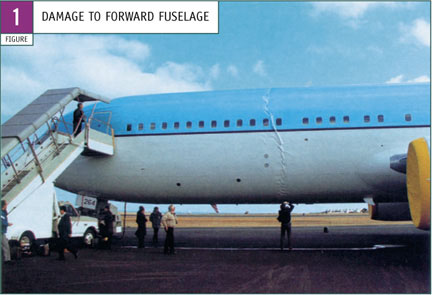 An airplane was on approach to a relatively short runway in gusty conditions. The airplane experienced a normal main gear touchdown, but the full forward column movement applied by the flight crew caused very hard nosegear contact with the runway. Resulting damage included displaced nosegear, bent axles, and a buckled and cracked fuselage structure (Figure 1). In addition, the cockpit door, forward lavatory doors, and forward passenger doors were jammed closed.
An airplane was on approach to a relatively short runway in gusty conditions. The airplane experienced a normal main gear touchdown, but the full forward column movement applied by the flight crew caused very hard nosegear contact with the runway. Resulting damage included displaced nosegear, bent axles, and a buckled and cracked fuselage structure (Figure 1). In addition, the cockpit door, forward lavatory doors, and forward passenger doors were jammed closed.
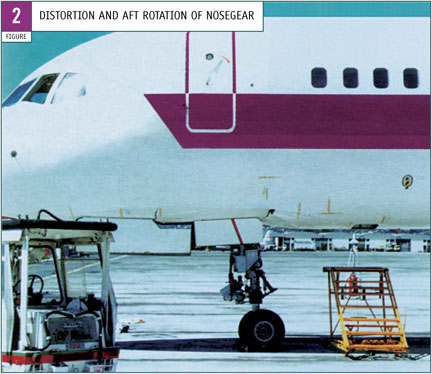 An airplane returned to the departure airport following an in-flight engine shutdown. The airplane landed firmly on the main gear. Recordings by the digital flight data recorder ended abruptly because of damage from the nosegear contact; however, the last data point showed that considerable forward control column movement had been applied. The nosegear was rotated aft and to the left of its normal position, resulting in damage to the lower fuselage and nosegear wheel well area (figure 2).
An airplane returned to the departure airport following an in-flight engine shutdown. The airplane landed firmly on the main gear. Recordings by the digital flight data recorder ended abruptly because of damage from the nosegear contact; however, the last data point showed that considerable forward control column movement had been applied. The nosegear was rotated aft and to the left of its normal position, resulting in damage to the lower fuselage and nosegear wheel well area (figure 2).
An airplane landing in strong crosswinds and turbulent conditions touched down on the main gear firmly, but not abnormally for the conditions. The airplane bounced, full forward column movement was applied, and the nosegear contacted the runway very hard, causing the nosegear to fail and rotate upward in the aft direction. The nosegear wheel assembly penetrated the electronics bay and caused considerable damage (figure 3).
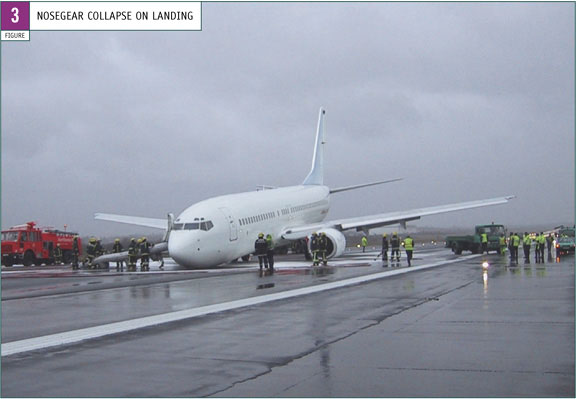
2. STRUCTURAL DESIGN REQUIREMENTS
Boeing first recognised that heavy loads on the nosegear could damage the fuselage structure during the 727-200 flight-test program in the 1960s. Flight-test data from various landings with high nose-down pitch rates led Boeing to enhance design requirements. These new requirements enabled the nosegear and fuselage structure to withstand harder nosegear contacts. All Boeing-designed airplane models meet these requirements.
The most recent design enhancements involve the 767. The 767-300 nosegear metering pin has been further optimised to absorb the energy produced during over-de-rotation events, thereby lowering the load on the nosegear (figure 4). The metering pin device controls the flow of hydraulic fluid within the nosegear oleo strut. The design enhancement was incorporated into production airplanes in August 1994 and is available for retrofit on earlier 767-300s.
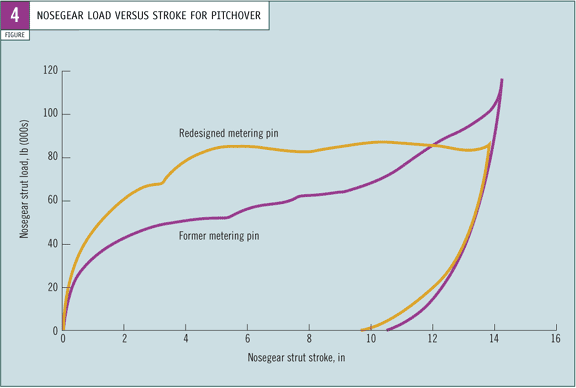
In addition, the upper crown stringers on the forward fuselage of the 767-300 have been strengthened in the area where buckling often occurs following over-de-rotation. This design enhancement was incorporated into production airplanes in January 1995. No retrofit is available for this design enhancement.
3. AIRPLANE CONTROL DURING LANDING AND DEROTATION
In the last several years, there has been an increase in the incidence of airframe damage from hard nosegear contacts. Examination of airplane flight recorder data from these incidents revealed that, in each case, full or nearly full forward column movement was applied between the time of main gear contact and nosegear touchdown. Figure 5 shows that enough nose-down elevator authority exists to damage the airframe structure if the airplane is rapidly de-rotated following main gear touchdown. This is possible because the maximum nose-down elevator authority is designed to control goarounds, which require considerably more longitudinal control than the landing manoeuvre.

In response to recent incidents, Boeing has produced a training video to increase flight crew awareness of the potential for both nosegear and airframe damage as a consequence of over-de-rotation. Based on a successful training effort in 1994 and 1995 that significantly reduced hard nosegear landings worldwide for several years, the video serves as a refresher for flight crews. The nine-minute video has been sent to all Boeing airline customers. (For information on how to obtain additional copies, refer to the editor's note at the end of this article.)
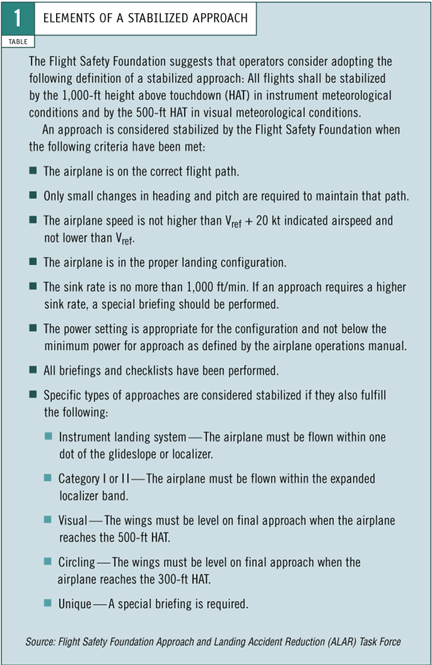 Many factors influence a successful landing and de-rotation. First, the approach must be stabilised, as defined by the Flight Safety Foundation (table 1). If these criteria are not met at any time before touchdown, the flight crew should initiate a go-around.
Many factors influence a successful landing and de-rotation. First, the approach must be stabilised, as defined by the Flight Safety Foundation (table 1). If these criteria are not met at any time before touchdown, the flight crew should initiate a go-around.
On approach, the speed-brake lever should be armed for landing and the autobrakes should be set for the runway surface conditions. The landing de-rotation should be performed so that the flight crew immediately starts flying the nosewheels smoothly onto the runway when the main wheels touch down.
Flight crews can accomplish this by controlling the airplane pitch rate while relaxing aft column pressure. When heavy brake applications are needed, with and without autobrakes, increased aft column pressure may be required to slow the de-rotation rate. Flight crews should not hold the nose up in the touchdown attitude or allow the nose to rise because either could result in a tail strike. Control column movement forward of the neutral position should not be needed. Figure 6 illustrates this smooth relaxation of column force as the nose is lowered. The figure compares the radio altitude, pitch angle, and control column forces for both normal landings and landings during which airframe damage occurred.
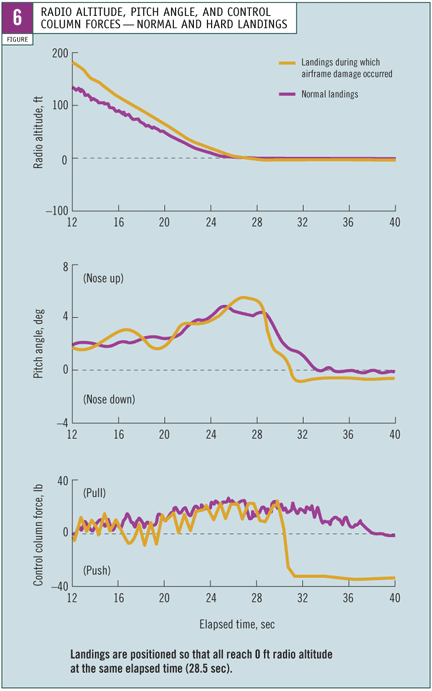
With the nose down, spoilers up, and thrust reversers deployed, the airplane is in the correct stopping configuration. This should be established as soon as is practical during landing. Forward column movement should not be applied to lower the nose rapidly in an effort to improve landing performance or directional control. The rudder provides the required directional control until the airplane is at a relatively low speed, then rudder pedal nosewheel steering is used to complete the landing rollout. Large forward column displacement does not improve the effectiveness of nosewheel steering and may reduce the effectiveness of main-wheel braking because it reduces the amount of weight on the main gear.
If the airplane bounces, the flight crew should hold or re-establish a normal landing attitude and add thrust as necessary to control the rate of descent. Thrust need not be added for a shallow bounce or skip. When a high, hard bounce occurs, the flight crew should initiate a go-around.
SummaryFlight crews can reduce the chances of airplane damage from hard nosegear contact by avoiding high de-rotation rates and excessive forward column inputs. In the event of a hard landing, the flight crew should report the event to the engineering and maintenance departments so that the airplane can be inspected for potential structural damage. |
Editor's note: A Boeing training video, "Airplane Derotation: A Matter of Seconds," covers the material presented in this article. Copies of the nine-minute video have been sent to all commercial airplane customers. Additional copies are available from the director of Flight Technical Services, Boeing Commercial Airplanes, P.O. Box 3707, Mail Code 20-97, Seattle, WA 98124-2207, USA; telephone 206-662-7800. Additional information on hard nosegear contact is available in Boeing Commercial Airplanes Flight Operations Technical Bulletins No's. 757-48 and 767-47, Feb. 1, 1993.
JEFF BLAND
MANAGER
DYNAMIC LOADS
BOEING COMMERCIAL AIRPLANES
DAVID CARBAUGH
CHIEF PILOT
FLIGHT OPERATIONS SAFETY
BOEING COMMERCIAL AIRPLANES
| Top of page | Boeing Home | Boeing Commercial | Contact Aero |
Aero Copyright © 2003 The Boeing Company. All rights reserved.
